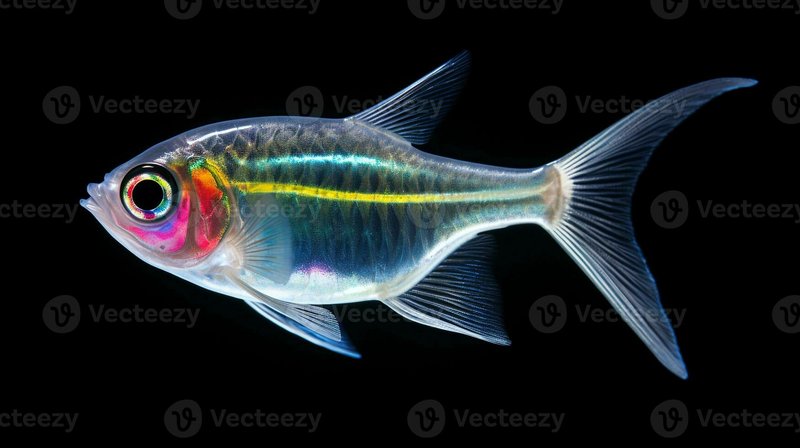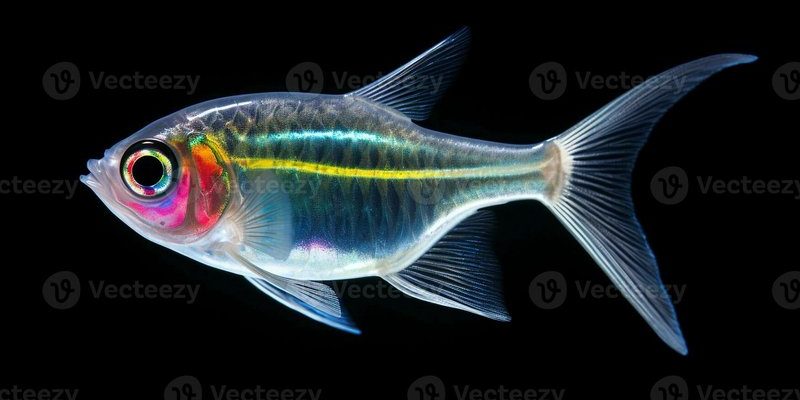
Understanding how the X-Ray tetra thrives is not just about looking at its physical features. It’s also about realizing how these adaptations connect with its environment. Picture yourself in a lush, green forest—each tree, plant, and creature plays a role in the ecosystem. Similarly, the adaptations of the X-Ray tetra allow it to be part of a larger aquatic community. So, grab your metaphorical snorkel, and let’s explore what makes the X-Ray tetra so unique!
Transparent Body: Nature’s Cloak of Camouflage
One of the most striking features of the X-Ray tetra is its transparent body. This isn’t just a cool party trick; it’s a survival mechanism. The fish is mostly see-through, which allows it to blend into its surroundings. When swimming in the murky waters of the Amazon, this transparency makes it harder for predators to spot them.
But here’s the thing—it’s not just the transparency that helps. The X-Ray tetra’s body is also designed with a silvery sheen. This sheen reflects light, making it even harder to see. Imagine wearing a pair of reflective sunglasses on a sunny day; you’d be much harder to spot! This clever adaptation allows the X-Ray tetra to evade predators like larger fish or birds diving for a snack.
How It Works
When light hits the water, it scatters. The X-Ray tetra capitalizes on this natural phenomenon. By being both transparent and reflective, it creates a natural illusion that makes it blend seamlessly with the rippling water. You might be wondering how this affects their behavior. Well, it allows them to be more active and bold since they feel safer from lurking dangers.
Social Behavior: Schooling for Safety
Another important adaptation of the X-Ray tetra is its social behavior. These little fish are known to be schooling fish, which means they thrive when they’re in groups. This isn’t just for social fun; it’s a smart survival tactic. When they school together, they create a larger target for predators. It’s kind of like a team sport—working together makes them stronger!
You may have seen fish moving in unison, darting left and right. This coordinated movement confuses predators, making it harder for them to pick out a single fish. In a way, schooling is their version of a defensive strategy, helping to ensure their survival in an environment full of hungry eyes.
The Importance of Groups
This behavior also plays a role in foraging for food. Just like how friends share tasty snacks, schooling fish can more easily find food together. They communicate through body movements and subtle changes in color, alerting each other to potential food sources. It’s a splendid example of teamwork in the animal kingdom!
Diet and Feeding Adaptations
The dietary habits of the X-Ray tetra showcase yet another adaptation. These fish are omnivores, meaning they eat a mix of plant and animal matter. Their diet can include tiny insects, crustaceans, and even plant material, which keeps them healthy and ready to thrive in their environment.
To catch their food, the X-Ray tetra has specially adapted mouths. Their small, delicate jaws allow them to pick at fine food particles in the water. Picture trying to catch a fly with a pair of chopsticks—if you adapt your technique, you’re more likely to succeed! This ability to nibble on small bits of food shows how well-suited they are to their environment.
Feeding Strategy
When foraging, these fish often take advantage of surface feeding. This is when they swim near the water’s surface, snagging tiny insects or larvae. Their schooling behavior aids this too—more eyes mean better chances of spotting food! It’s like having a large group of friends at a buffet; the more people you have, the more food you find!
Adaptations to Create a Comfortable Habitat
The X-Ray tetra thrives in specific habitats—typically in slow-moving waters with plenty of vegetation. That’s where their adaptations come into play. They prefer areas with dense foliage, which offers both shelter and a hunting ground.
This preference for plants isn’t random. The vegetation provides hiding spots from predators and is often rich in food sources, like insects and algae. Imagine living in a cozy house with your favorite snacks within reach—sounds pretty ideal, right?
Importance of Vegetation
Moreover, the plants in their habitat help maintain good water quality. They create oxygen and absorbing excess nutrients that could harm the fish. It’s like living in a well-cared-for garden, where everything seems to thrive together. This connection between the X-Ray tetra and its environment illustrates how intertwined their adaptations are with their habitat.
Breeding and Parental Care Adaptations
Breeding is another crucial aspect of the X-Ray tetra’s life that showcases their adaptability. Unlike many fish species, which simply lay eggs and swim away, X-Ray tetras exhibit more intricate behaviors. They usually spawn in groups, allowing for a higher chance of mating success.
Once the eggs are laid, there’s limited parental care, but the sheer number of eggs helps ensure that at least some survive. Think of it like planting a garden—if you scatter enough seeds, a few are bound to grow! This strategy increases their chances of continuing their lineage despite the dangers of their environment.
Role of Surroundings in Breeding
The presence of vegetation also plays a role in their breeding. Plants provide not only shelter for the young fish but also a good source of food. As the baby X-Ray tetras emerge, they can find tiny particles in the plants to munch on—talk about a cozy start to life!
The X-Ray tetra is a perfect example of how adaptations help an animal thrive in its environment. From its sleek, transparent body to its social schooling behavior, these fish have evolved smart strategies to survive and flourish. As you dive deeper into the world of these little creatures, it’s clear that their adaptations are perfectly tailored to the Amazon’s unique ecosystem.
So, the next time you see an X-Ray tetra, remember it’s not just a colorful fish. It’s a vibrant part of a complex web of life, showcasing nature’s brilliance in each fin and scale. These adaptations are just a snapshot of what makes the underwater world so captivating, reminding us how every creature, no matter how small, has a role to play in the grand scheme of life.

